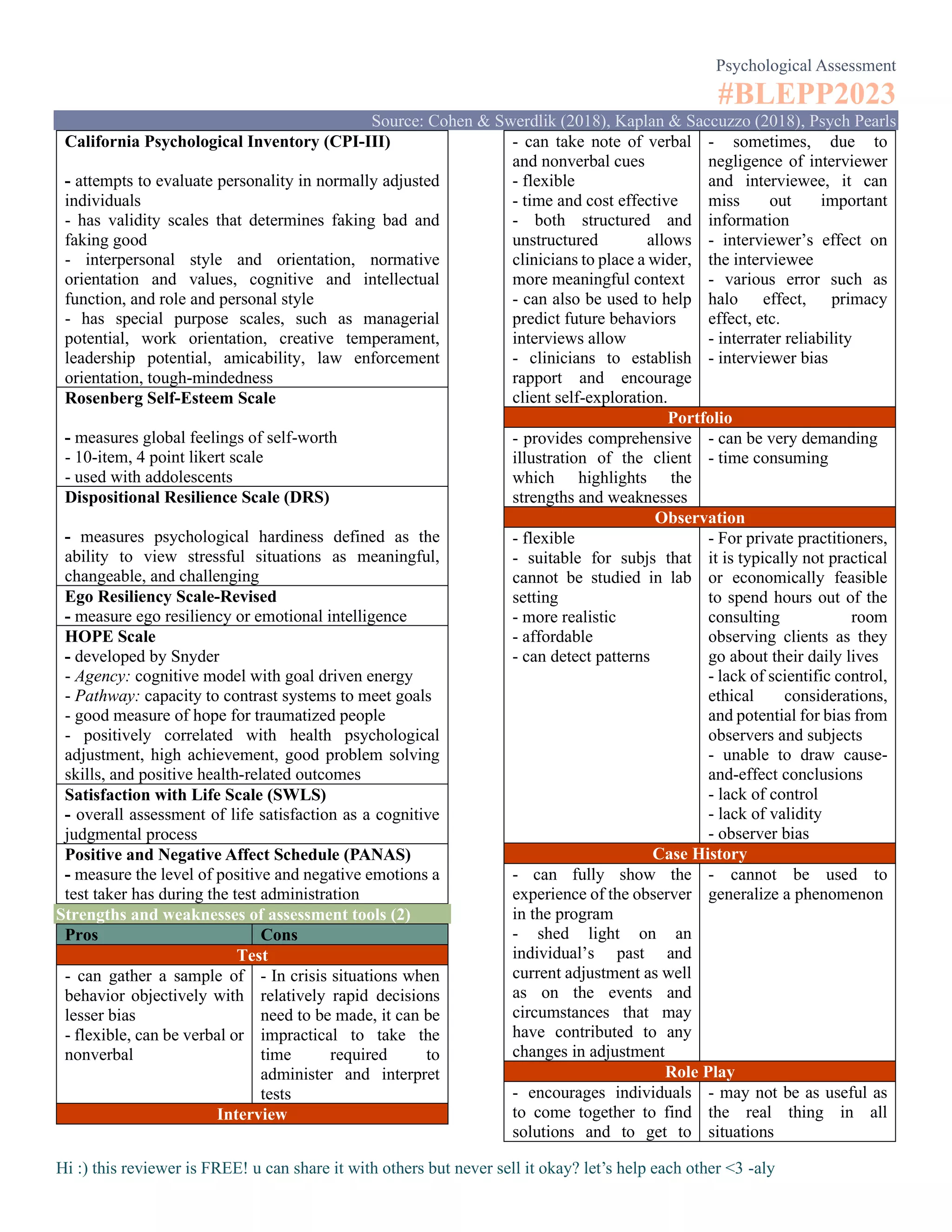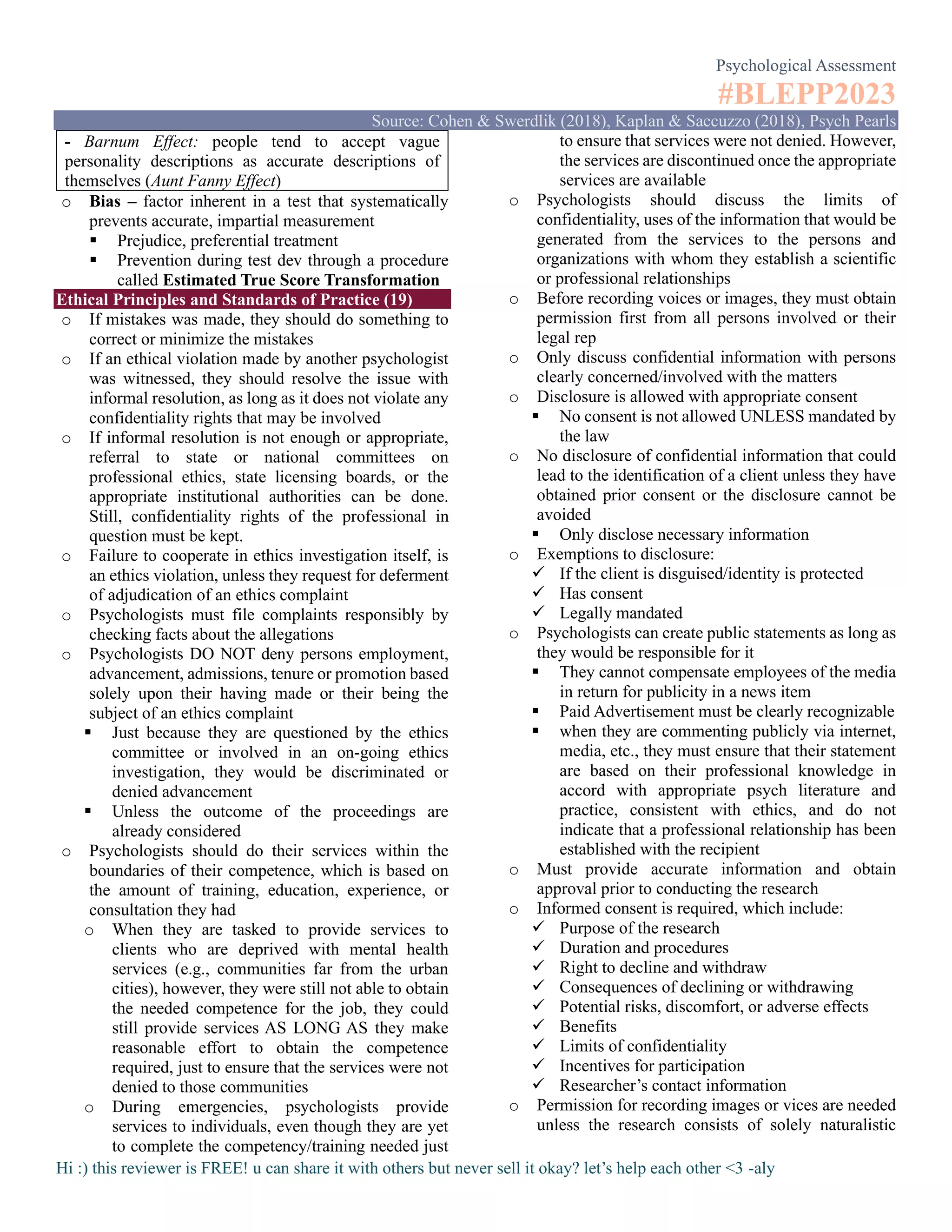The document provides an overview of psychological assessment, detailing the processes, types of tests, and key principles involved in measuring psychology-related variables. It discusses psychometric properties, evaluation methods, and the roles of various participants in the assessment process, emphasizing the importance of reliability and validity. Additionally, it outlines assumptions about psychological traits and states, measurement techniques, and potential errors in testing.





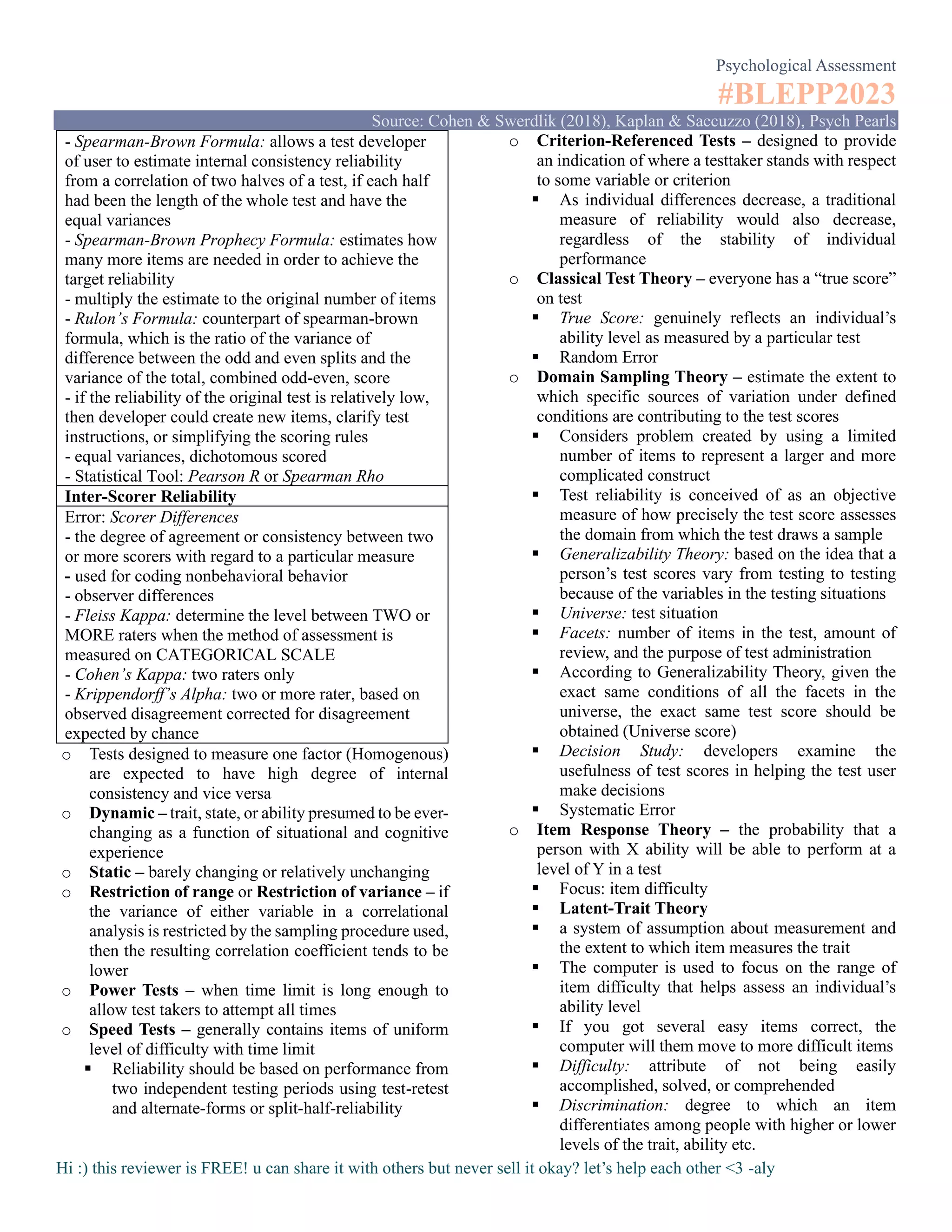


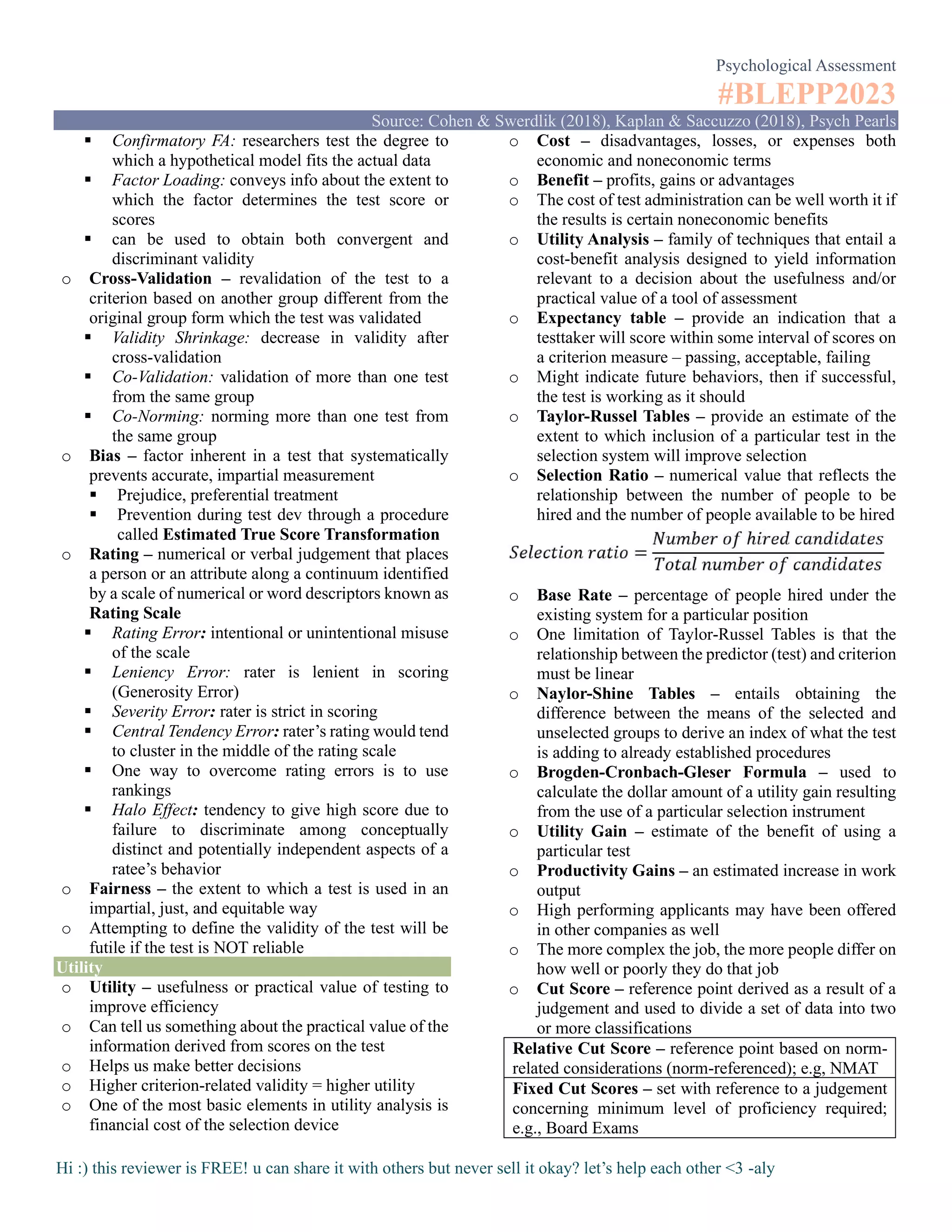
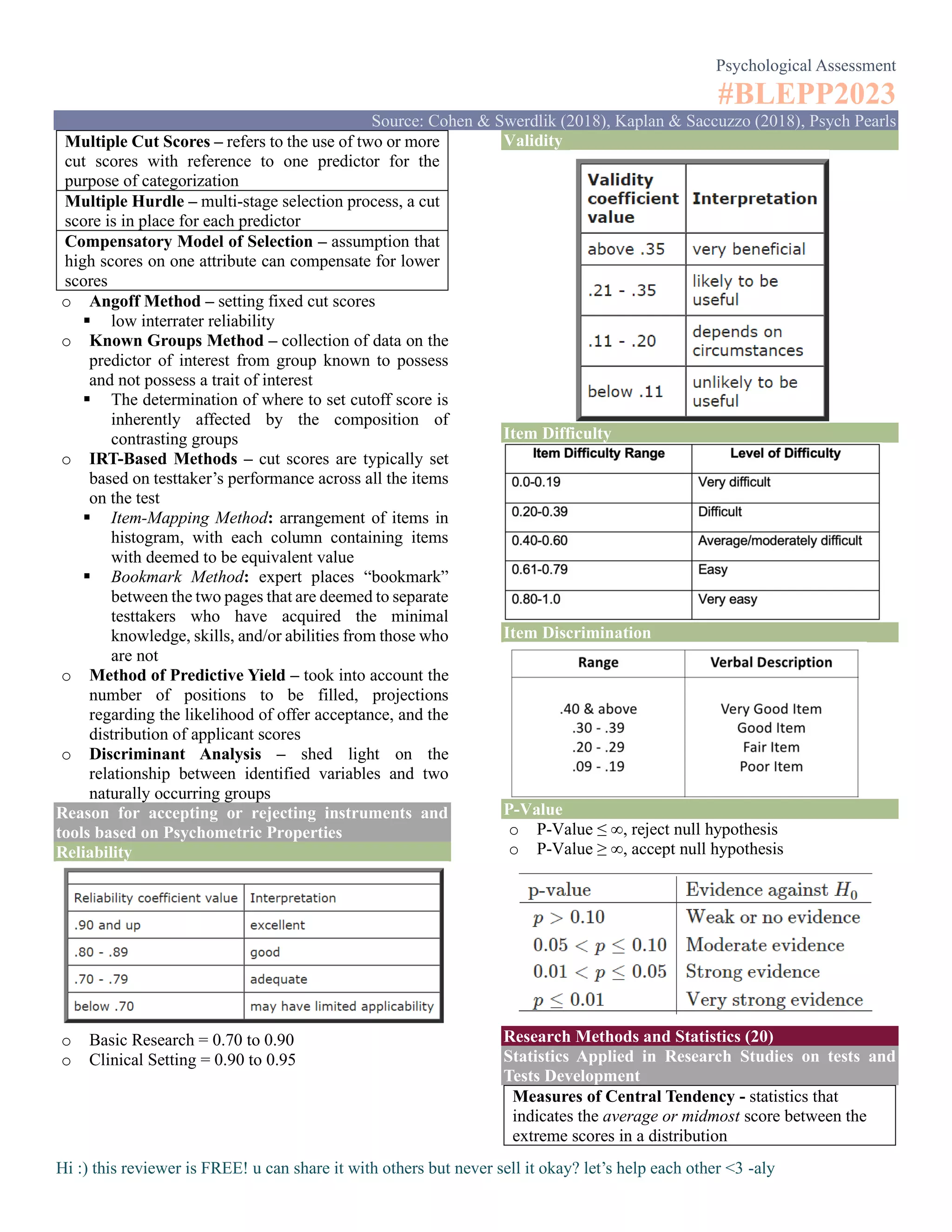
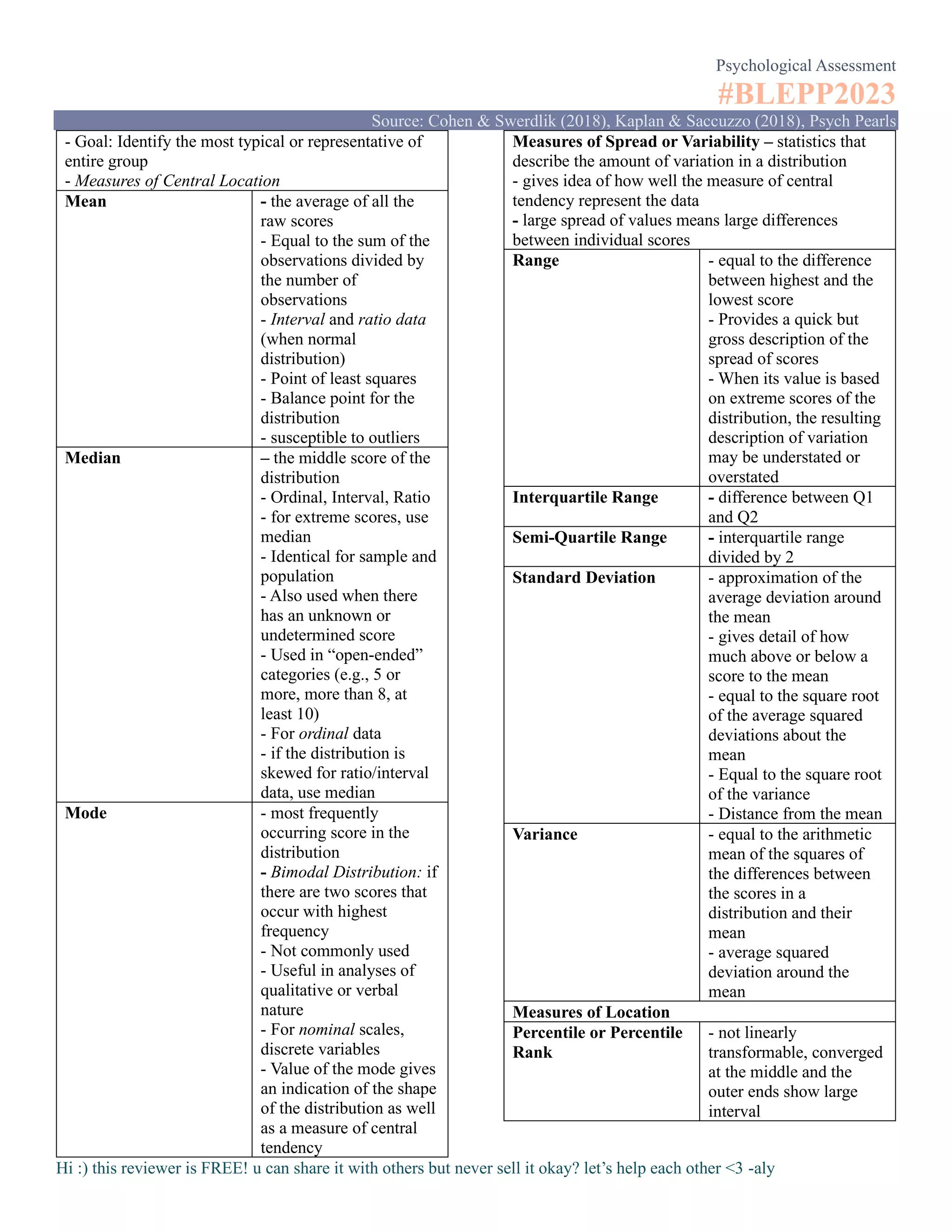



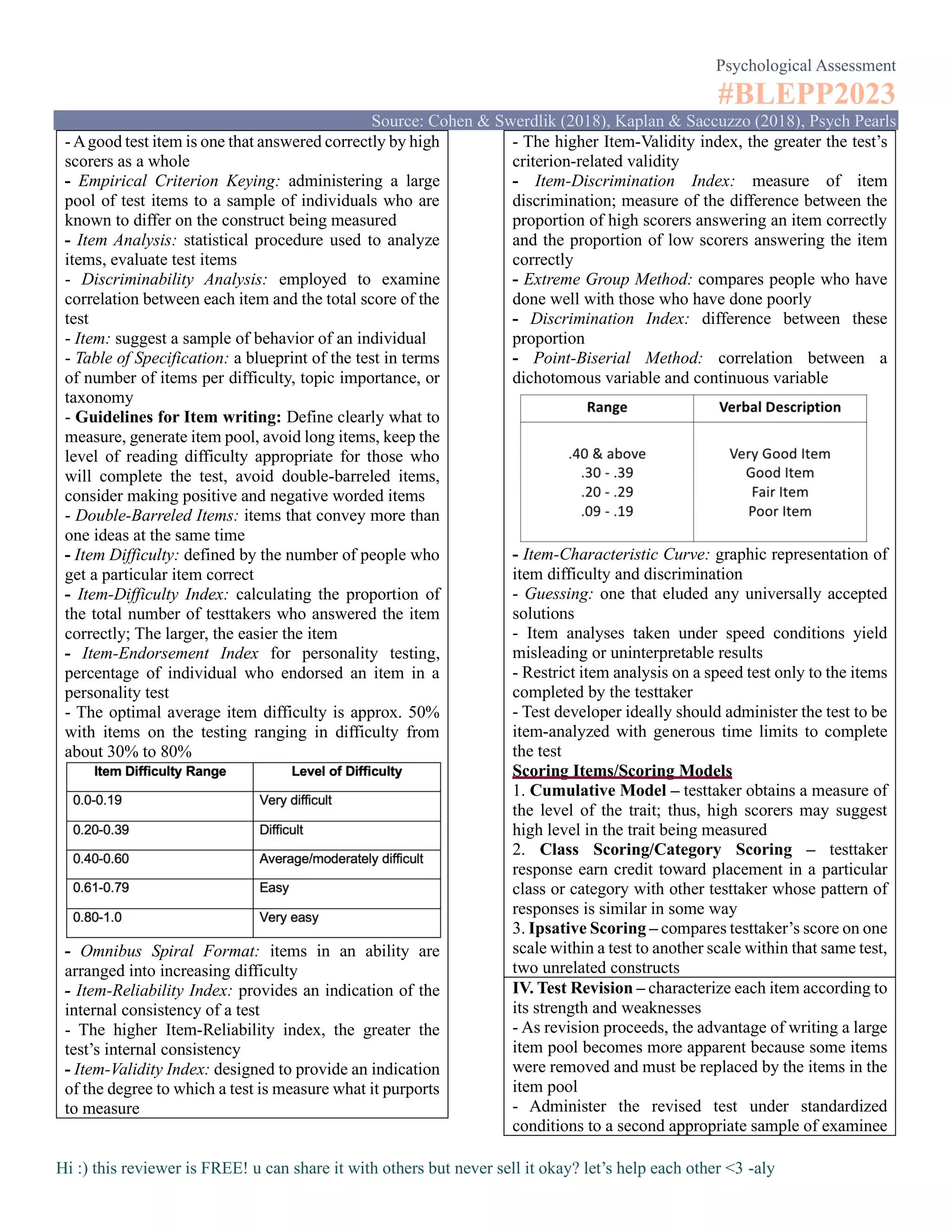

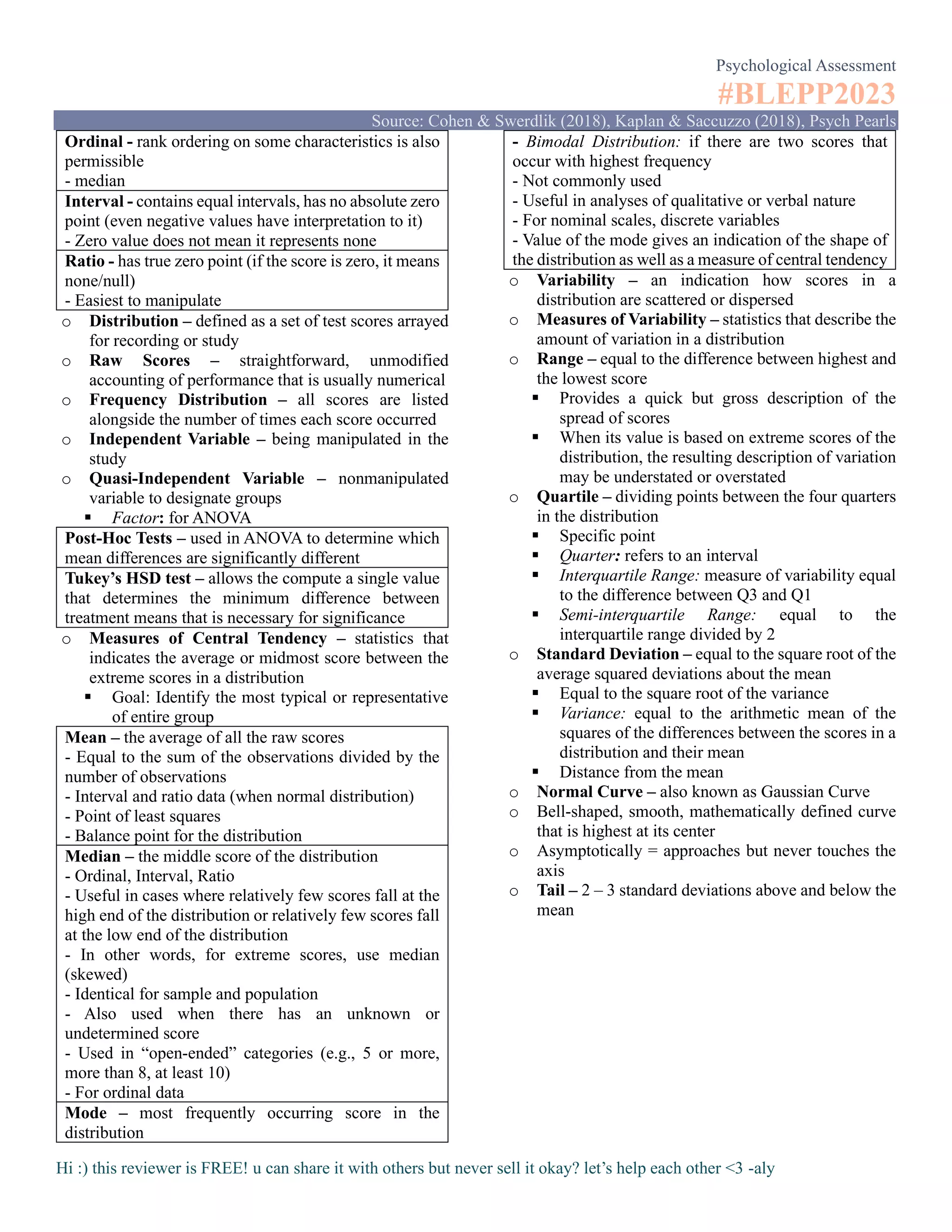
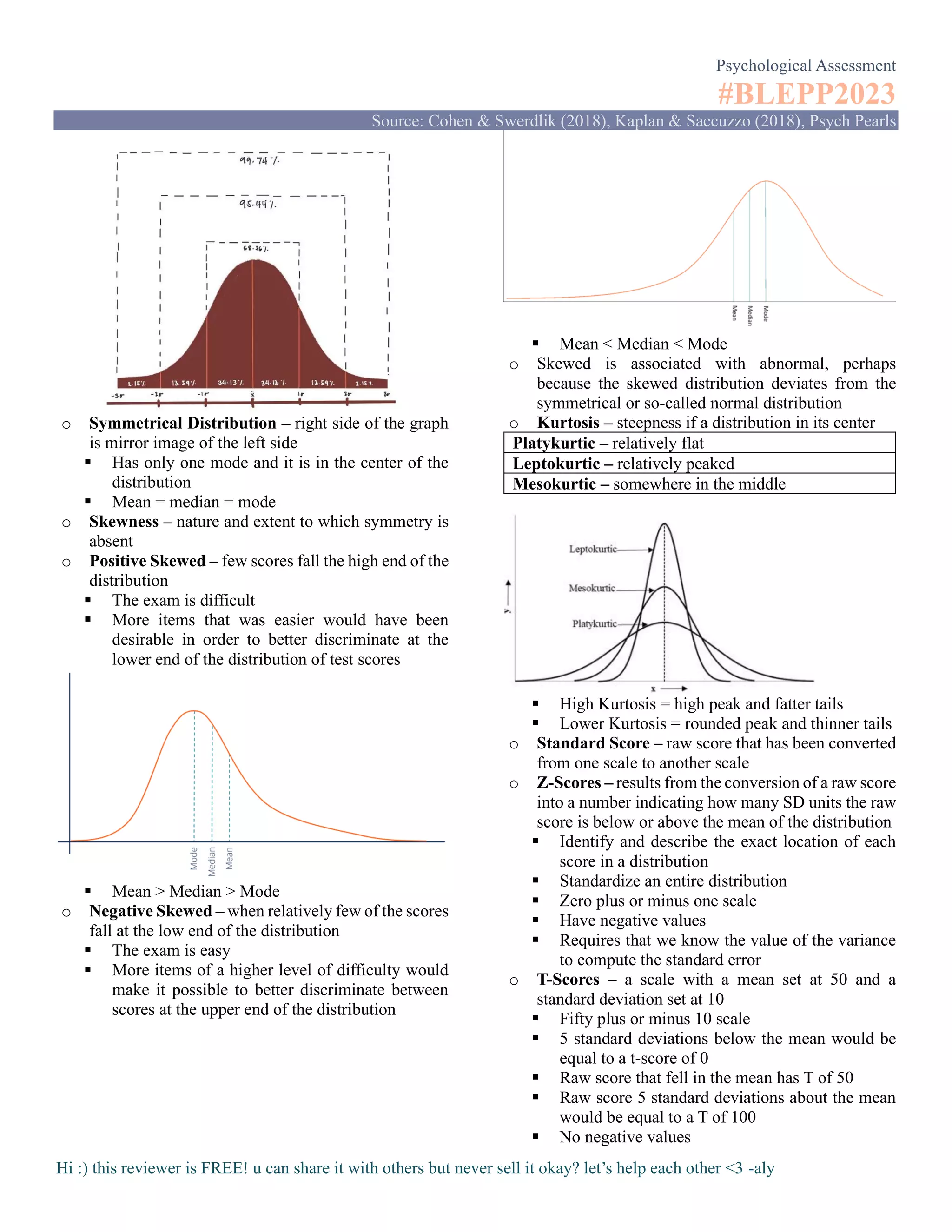
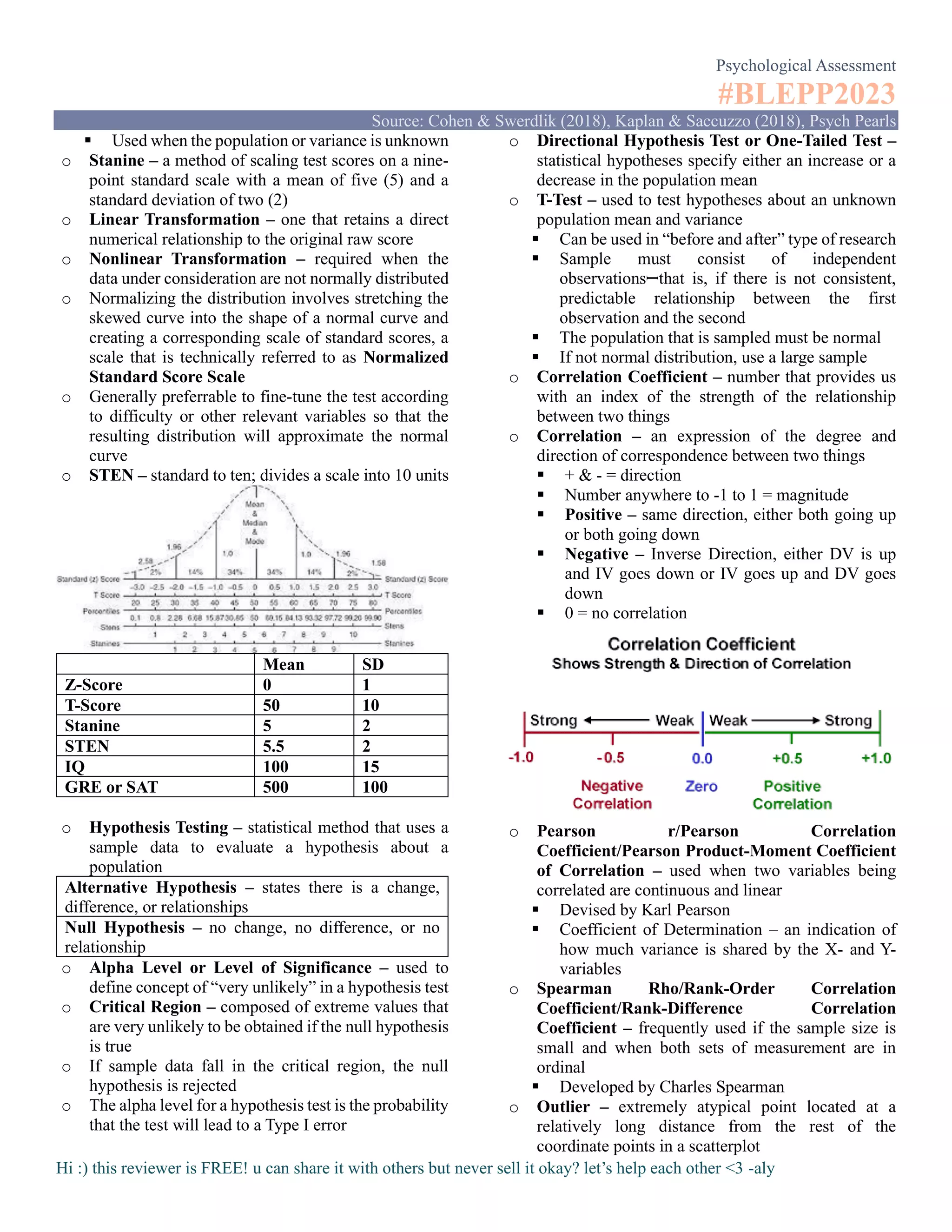
![Psychological Assessment
#BLEPP2023
Source: Cohen & Swerdlik (2018), Kaplan & Saccuzzo (2018), Psych Pearls
Hi :) this reviewer is FREE! u can share it with others but never sell it okay? let’s help each other <3 -aly
o Regression Analysis – used for prediction
▪ Predict the values of a dependent or response
variable based on values of at least one
independent or explanatory variable
▪ Residual: the difference between an observed
value of the response variable and the value of the
response variable predicted from the regression
line
▪ The Principle of Least Squares
▪ Standard Error of Estimate: standard deviation of
the residuals in regression analysis
▪ Slope: determines how much the Y variable
changes when X is increased by 1 point
o T-Test (Independent) – comparison or determining
differences
▪ 2 different groups/independent samples +
interval/ratio scales (continuous variables)
Equal Variance – 2 groups are equal
Unequal Variance – groups are unequal
o T-test (Dependent)/Paired Test – one groups
nominal (either matched or repeated measures) + 2
treatments
o One-Way ANOVA– 3 or more IV, 1 DV comparison
of differences
o Two-Way ANOVA – 2 IV, 1 DV
o Critical Value – reject the null and accept the
alternative if [ obtained value > critical value ]
o P-Value (Probability Value) – reject null and accept
alternative if [ p-value < alpha level ]
o Norms – refer to the performances by defined groups
on a particular test
o Age-Related Norms – certain tests have different
normative groups for age groups
o Tracking – tendency to stay at about the same level
relative to one’s peers
Norm-Referenced Tests – compares each person with
the norm
Criterion-Referenced Tests – describes specific types
of skills, tasks, or knowledge that the test taker can
demonstrate
Selection of Assessment Methods and Tools and Uses,
Benefits, and Limitations of Assessment tools and
instruments (32)
Identify appropriate assessment methods, tools (2)
1. Test – measuring device or procedure
- Psychological Test: device or procedure designed to
measure variables related to psychology
Ability or Maximal Performance Test – assess what
a person can do
a. Achievement Test – measurement of the previous
learning
b. Aptitude – refers to the potential for learning or
acquiring a specific skill
c. Intelligence – refers to a person’s general potential
to solve problems, adapt to changing environments,
abstract thinking, and profit from experience
Human Ability – considerable overlap of
achievement, aptitude, and intelligence test
Typical Performance Test – measure usual or habitual
thoughts, feelings, and behavior
Personality Test – measures individual dispositions
and preferences
a. Structured Personality tests – provide statement,
usually self-report, and require the subject to choose
between two or more alternative responses
b. Projective Personality Tests – unstructured, and the
stimulus or response are ambiguous
c. Attitude Test – elicit personal beliefs and opinions
d. Interest Inventories – measures likes and dislikes
as well as one’s personality orientation towards the
world of work
- Purpose: for evaluation, drawing conclusions of some
aspects of the behavior of a person, therapy, decision-
making
- Settings: Industrial, Clinical, Educational,
Counseling, Business, Courts, Research
- Population: Test Developers, Test Publishers, Test
Reviewers, Test Users, Test Sponsors, Test Takers,
Society
Levels of Tests
1. Level A – anyone under a direction of a supervisor
or consultant
2. Level B – psychometricians and psychologists only
3. Level C – psychologists only
2. Interview – method of gathering information
through direct communication involving reciprocal
exchange
- can be structured, unstructured, semi-structured, or
non-directive
- Mental Status Examination: determines the mental
status of the patient
- Intake Interview: determine why the client came for
assessment; chance to inform the client about the
policies, fees, and process involved
- Social Case: biographical sketch of the client
- Employment Interview: determine whether the
candidate is suitable for hiring
- Panel Interview (Board Interview): more than one
interviewer participates in the assessment
- Motivational Interview: used by counselors and
clinicians to gather information about some
problematic behavior, while simultaneously attempting
to address it therapeutically](https://image.slidesharecdn.com/psyassessment-230803125555-e35176f6/75/BLEPP-Reviewer-Psychological-Assessment-20-2048.jpg)
![Psychological Assessment
#BLEPP2023
Source: Cohen & Swerdlik (2018), Kaplan & Saccuzzo (2018), Psych Pearls
Hi :) this reviewer is FREE! u can share it with others but never sell it okay? let’s help each other <3 -aly
3. Portfolio – samples of one’s ability and
accomplishment
- Purpose: Usually in industrial settings for evaluation
of future performance
4. Case History Data – refers to records, transcripts,
and other accounts in written, pictorial, or other form
that preserve archival information, official and
informal accounts, and other data and items relevant to
an assessee
5. Behavioral Observation – monitoring of actions of
others or oneself by visual or electronic means while
recording quantitative and/or qualitative information
regarding those actions
- Naturalistic Observation: observe humans in natural
setting
6. Role Play – defined as acting an improvised or
partially improvised part in a stimulated situation
- Role Play Test: assesses are directed to act as if they
are in a particular situation
- Purpose: Assessment and Evaluation
- Settings: Industrial, Clinical
- Population: Job Applicants, Children
7. Computers – using technology to assess an client,
thus, can serve as test administrators and very efficient
test scorers
8. Others: videos, biofeedback devices
Intelligence Tests
Stanford-Binet Intelligence Scale 5th
Ed. (SB-5)
[ C ]
- 2-85 years old
- individually administered
- norm-referenced
- Scales: Verbal, Nonverbal, and Full Scale (FSIQ)
- Nonverbal and Verbal Cognitive Factors: Fluid
Reasoning, Knowledge, Quantitative Reasoning,
Visual-Spatial Processing, Working Memory
- age scale and point-scale format
- originally created to identify mentally disabled
children in Paris
- 1908 Scale introduced Age Scale format and Mental
Age
- 1916 scale significantly applied IQ concept
- Standard Scores: 100 (mean), 15 (SD)
- Scaled Scores: 10 (mean), 3 (SD)
- co-normed with Bender-Gestalt and Woodcock-
Johnson Tests
- based on Cattell-Horn-Carroll Model of General
Intellectual Ability
- no accommodations for pwds
- 2 routing tests
- w/ teaching items, floor level, and ceiling level
- provides behavioral observations during
administration
Wechsler Intelligence Scales (WAIS-IV, WPPSI-IV,
WISC-V)
[ C ]
- WAIS (16-90 years old), WPPSI (2-6 years old),
WISC (6-11)
- individually administered
- norm-referenced
- Standard Scores: 100 (mean), 15 (SD)
- Scaled Scores: 10 (mean), 3 (SD)
- addresses the weakness in Stanford-Binet
- could also assess functioning in people with brain
injury
- evaluates patterns of brain dysfunction
- yields FSIQ, Index Scores (Verbal Comprehension,
Perceptual Reasoning, Working Memory, and
Processing Speed), and subtest-level scaled scores
Raven’s Progressive Matrices (RPM)
[ B ]
- 4 – 90 years old
- nonverbal test
- used to measure general intelligence & abstract
reasoning
- multiple choice of abstract reasoning
- group test
- IRT-Based
Culture Fair Intelligence Test (CFIT)
[ B]
- Nonverbal instrument to measure your analytical and
reasoning ability in the abstract and novel situations
- Measures individual intelligence in a manner
designed to reduced, as much as possible, the influence
of culture
- Individual or by group
- Aids in the identification of learning problems and
helps in making more reliable and informed decisions
in relation to the special education needs of children
Purdue Non-Language Test
[ B ]
- Designed to measure mental ability, since it consists
entirely of geometric forms
- Culture-fair
- Self-Administering
Panukat ng Katalinuhang Pilipino
- Basis for screening, classifying, and identifying needs
that will enhance the learning process
- In business, it is utilized as predictors of occupational
achievement by gauging applicant’s ability and fitness
for a particular job](https://image.slidesharecdn.com/psyassessment-230803125555-e35176f6/75/BLEPP-Reviewer-Psychological-Assessment-21-2048.jpg)
![Psychological Assessment
#BLEPP2023
Source: Cohen & Swerdlik (2018), Kaplan & Saccuzzo (2018), Psych Pearls
Hi :) this reviewer is FREE! u can share it with others but never sell it okay? let’s help each other <3 -aly
- Essential for determining one’s capacity to handle the
challenges associated with certain degree programs
- Subtests: Vocabulary, Analogy, Numerical Ability,
Nonverbal Ability
Wonderlic Personnel Test (WPT)
- Assessing cognitive ability and problem-solving
aptitude of prospective employees
- Multiple choice, answered in 12 minutes
Armed Services Vocational Aptitude Battery
- Most widely used aptitude test in US
- Multiple-aptitude battery that measures developed
abilities and helps predict future academic and
occupational success in the military
Kaufman Assessment Battery for Children-II
(KABC-II)
- Alan & Nadeen Kaufman
- for assessing cognitive development in children
- 13 to 18 years old
Personality Tests
Minnesota Multiphasic Personality Inventory
(MMPI-2)
[ C ]
- Multiphasic personality inventory intended for used
with both clinical and normal populations to identify
sources of maladjustment and personal strengths
- Starke Hathaway and J. Charnley McKinley
- Help in diagnosing mental health disorders,
distinguishing normal from abnormal
- should be administered to someone with no guilt
feelings for creating a crime
- individual or by groups
- Clinical Scales: Hypochondriasis, Depression,
Hysteria, Psychopathic Deviate,
Masculinity/Femininity, Paranoia, Psychasthenia
(Anxiety, Depression, OCD), Schizophrenia,
Hypomania, Social Introversion
- Lie Scale (L Scale): items that are somewhat negative
but apply to most people; assess the likelihood of the
test taker to approach the instrument with defensive
mindset
- High in L scale = faking good
- High in F scale = faking bad, severe distress or
psychopathology
- Superlative Self Presentation Scale (S Scale): a
measure of defensiveness; Superlative Self-
Presentation to see if you intentionally distort answers
to look better
- Correction Scale (K Scale): reflection of the frankness
of the testtaker’s self-report
- K Scale = reveals a person’s defensiveness around
certain questions and traits; also faking good
- K scale sometimes used to correct scores on five
clinical scales. The scores are statistically corrected for
an individual’s overwillingness or unwillingness to
admit deviance
- “Cannot Say” (CNS) Scale: measures how a person
doesn’t answer a test item
- High ? Scale: client might have difficulties with
reading, psychomotor retardation, or extreme
defensiveness
- True Response Inconsistency (TRIN): five true, then
five false answers
- Varied Response Inconsistency (VRIN): random true
or false
- Infrequency-Psychopathology Scale (Fp): reveal
intentional or unintentional over-reporting
- FBS Scale: “symptom validity scale” designed to
detect intentional over-reporting of symptoms
- Back Page Infrequency (Fb): reflects significant
change in the testtaker’s approach to the latter part of
the test
Myers-Briggs Type Indicator (MBTI)
- Katherine Cook Briggs and Isabel Briggs Myers
- Self-report inventory designed to identify a person’s
personality type, strengths, and preferences
- Extraversion-Introversion Scale: where you prefer to
focus your attention and energy, the outer world and
external events or your inner world of ideas and
experiences
- Sensing-Intuition Scale: how do you take inform, you
take in or focus on interpreting and adding meaning on
the information
- Thinking-Feeling Scale: how do you make decisions,
logical or following what your heart says
- Judging-Perceiving Scale: how do you orient the
outer world? What is your style in dealing with the
outer world – get things decided or stay open to new
info and options?
Edward’s Preference Personality Schedule (EPPS)
[ B ]
- designed primarily as an instrument for research and
counselling purposes to provide quick and convenient
measures of a number of relatively normal personality
variables
- based of Murray’s Need Theory
- Objective, forced-choice inventory for assessing the
relative importance that an individual places on 15
personality variables
- Useful in personal counselling and with non-clinical
adults
- Individual](https://image.slidesharecdn.com/psyassessment-230803125555-e35176f6/75/BLEPP-Reviewer-Psychological-Assessment-22-2048.jpg)
![Psychological Assessment
#BLEPP2023
Source: Cohen & Swerdlik (2018), Kaplan & Saccuzzo (2018), Psych Pearls
Hi :) this reviewer is FREE! u can share it with others but never sell it okay? let’s help each other <3 -aly
Guilford-Zimmerman Temperament Survey
(GZTS)
- items are stated affirmatively rather than in question
form, using the 2nd
person pronoun
- measures 10 personality traits: General Activity,
Restraint,Ascendance, Sociability, Emotional Stability,
Objectivity, Friendliness, Thoughtfulness, Personal
Relations, Masculinity
NEO Personality Inventory (NEO-PI-R)
- Standard questionnaire measure of the Five Factor
Model, provides systematic assessment of emotional,
interpersonal, experiential, attitudinal, and
motivational styles
- gold standard for personality assessment
- Self-Administered
- Neuroticism: identifies individuals who are prone to
psychological distress
- Extraversion: quantity and intensity of energy
directed
- Openness To Experience: active seeking and
appreciation of experiences for their own sake
- Agreeableness: the kind of interactions an individual
prefers from compassion to tough mindedness
- Conscientiousness: degree of organization,
persistence, control, and motivation in goal-directed
behavior
Panukat ng Ugali at Pagkatao/Panukat ng
Pagkataong Pilipino
- Indigenous personality test
- Tap specific values, traits and behavioral dimensions
related or meaningful to the study of Filipinos
Sixteen Personality Factor Questionnaire
- Raymond Cattell
- constructed through factor analysis
- Evaluates a personality on two levels of traits
- Primary Scales: Warmth, Reasoning, Emotional
Stability, Dominance, Liveliness, Rule-Consciousness,
Social Boldness, Sensitivity, Vigilance,
Abstractedness, Privateness, Apprehension, Openness
to change, Self-Reliance, Perfectionism, Tension
- Global Scales: Extraversion, Anxiety, Tough-
Mindedness, Independence, Self-Control
Big Five Inventory-II (BFI-2)
- Soto & John
- Assesses big 5 domains and 15 facets
- for commercial purposes to researches and students
Projective Tests
Rorshcach Inkblot Test
[ C ]
- Hermann Rorschach
- 5 years and older
- subjects look at 10 ambiguous inkblot images and
describe what they see in each one
- once used to diagnose mental illnesses like
schizophrenia
- Exner System: coding system used in this test
- Content: the name or class of objects used in the
patient’s responses
Content:
1. Nature
2. Animal Feature
3. Whole Human
4. Human Feature
5. Fictional/Mythical Human Detail
6. Sex
Determinants:
1. Form
2. Movement
3. Color
4. Shading
5. Pairs and Reflections
Location:
1. W – the whole inkblot was used to depict an image
2. D – commonly described part of the blot was used
3. Dd – an uncommonly described or unusual detail
was used
4. S – the white space in the background was used
Thematic Apperception Test
[ C ]
- Christiana Morgan and Henry Murray
- 5 and above
- 31 picture cards serve as stimuli for stories and
descriptions about relationships or social situations
- popularly known as the picture interpretation
technique because it uses a standard series of
provocative yet ambiguous pictures about which the
subject is asked to tell a story
- also modified African American testtakers
Children’s Apperception Test
- Bellak & Bellak
- 3-10 years old
- based on the idea that animals engaged in various
activities were useful in stimulating projective
storytelling by children
Hand Test
- Edward Wagner
- 5 years old and above](https://image.slidesharecdn.com/psyassessment-230803125555-e35176f6/75/BLEPP-Reviewer-Psychological-Assessment-23-2048.jpg)
![Psychological Assessment
#BLEPP2023
Source: Cohen & Swerdlik (2018), Kaplan & Saccuzzo (2018), Psych Pearls
Hi :) this reviewer is FREE! u can share it with others but never sell it okay? let’s help each other <3 -aly
- used to measure action tendencies, particularly acting
out and aggressive behavior, in adults and children
- 10 cards (1 blank)
Apperceptive Personality Test (APT)
- Holmstrom et. Al.
- attempt to address the criticisms of TAT
- introduced objectivity in scoring system
- 8 cards include male and female of different ages and
minority group members
- testtakers will respond to a series of multiple choice
questions after storytelling
Word Association Test (WAT)
- Rapaport et. Al.
- presentation of a list of stimulus words, assessee
responds verbally or in writing the first thing that
comes into their minds
Rotter Incomplete Sentences Blank (RISB)
- Julian Rotter & Janet Rafferty
- Grade 9 to Adulthood
- most popular SCT
SACK’s Sentence Completion Test (SSCT)
- Joseph Sacks and Sidney Levy
- 12 years old and older
- asks respondents to complete 60 questions with the
first thing that comes to mind across four areas: Family,
Sex, Interpersonal, Relationships and Self concept
Bender-Gestalt Visual Motor Test
[ C ]
- Lauretta Bender
- 4 years and older
- consists of a series of durable template cards, each
displaying a unique figure, then they are asked to draw
each figure as he or she observes it
- provides interpretative information about an
individual’s development and neuropsychological
functioning
- reveals the maturation level of visuomotor
perceptions, which is associated with language ability
and various functions of intelligence
House-Tree-Person Test (HTP)
- John Buck and Emmanuel Hammer
- 3 years and up
- measures aspects of a person’s personality through
interpretation of drawings and responses to questions
- can also be used to assess brain damage and general
mental functioning
- measures the person’s psychological and emotional
functioning
- The house reflects the person’s experience of their
immediate social world
- The tree is a more direct expression of the person’s
emotional and psychological sense of self
- The person is a more direct reflection of the person’s
sense of self
Draw-A-Person Test (DAP)
- Florence Goodenough
- 4 to 10 years old
- a projective drawing task that is often utilized in
psychological assessments of children
- Aspects such as the size of the head, placement of the
arms, and even things such as if teeth were drawn or
not are thought to reveal a range of personality traits
-Helps people who have anxieties taking tests (no strict
format)
-Can assess people with communication problems
-Relatively culture free
-Allow for self-administration
Kinetic Family Drawing
- Burns & Kaufman
- derived from Hulses’ FDT “doing something”
Clinical & Counseling Tests
Millon Clinical Multiaxial Scale-IV (MCMI-IV)
- Theodore Millon
- 18 years old and above
- for diagnosing and treatment of personality disorders
- exaggeration of polarities results to maladaptive
behavior
- Pleasure-Pain: the fundamental evolutionary task
- Active-Passive: one adapts to the environment or
adapts the environment to one’s self
- Self-Others: invest to others versus invest to oneself
Beck Depression Inventory (BDI-II)
- Aaron Beck
- 13 to 80 years old
- 21-item self-report that tapos Major Depressive
symptoms accdg. to the criteria in the DSM
MacAndrew Alcoholism Scale (MAC & MAC-R)
- from MMPI-II
- Personality & attitude variables thought to underlie
alcoholism](https://image.slidesharecdn.com/psyassessment-230803125555-e35176f6/75/BLEPP-Reviewer-Psychological-Assessment-24-2048.jpg)
